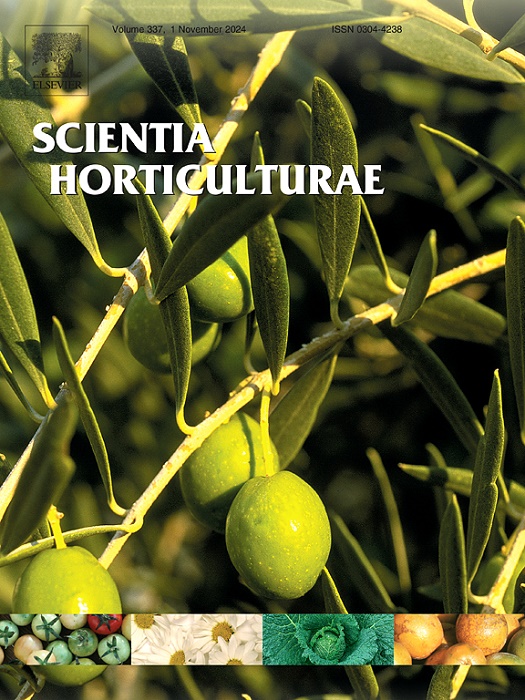不同比例的蓝光对向日葵生长和开花的影响
IF 3.9
2区 农林科学
Q1 HORTICULTURE
引用次数: 0
摘要
由于向日葵对光的敏感性,调节光谱成分对于优化向日葵的生长和开花以满足市场需求具有重大潜力。在本研究中,向日葵植株在白光(W200,对照)和三种蓝光(B40R80Fr80,蓝光强度为 40 µmol m-2 s-1;B67R67Fr67,蓝光强度为 67 µmol m-2 s-1;B100R50Fr50,蓝光强度为 100 µmol m-2 s-1)照射下,总辐照度水平为 200 µmol m-2 s-1,为期 60 天。目的是研究其对向日葵形态调节、叶片生长和开花的影响。结果表明,与 B67R67Fr67 和 B100R50Fr50 处理相比,20% 蓝光 B40R80Fr80 处理下向日葵的生长抑制了植株高度。B100R50Fr50 处理下的向日葵叶片总干重最高。与 B100R50Fr50 处理相比,B67R67Fr67 处理下的叶片提高了甘油醛-3-磷酸脱氢酶、果糖-1,6-二磷酸醛缩酶和可溶性淀粉合成酶的活性,Rubisco 活性也提高了 10.4%。与 B100R50Fr50 处理相比,B67R67Fr67 处理下的蔗糖和淀粉含量分别增加了 41.0 % 和 19.1 %。与 W200 处理相比,B67R67Fr67 处理下向日葵植株的花盘直径和每朵花的花瓣数明显增加。表型辅助转录组分析表明,与 B100R50Fr50 处理相比,B67R67Fr67 处理向日葵叶片对与开花相关的昼夜节律相关基因[CONSTITUTIVELY PHOTOMORPHOGENIC 1 (COP1) 和 FLOWERING LOCUS T (FT)]有积极影响。此外,在 B67R67Fr67 处理下,有四个与 GA 代谢相关的基因上调,它们是 LOC110884159 和 LOC110890361(GID1B)。与 B100R50Fr50 处理相比,B67R67Fr67 处理下向日葵叶片的 GA 含量增加,并诱导了与昼夜节律相关的 GA 通路。因此,实施 B67R67Fr67 处理可改善昼夜节律和 GA 通路的激活,从而诱导开花,满足市场对向日葵的需求。本文章由计算机程序翻译,如有差异,请以英文原文为准。
Response of blue light in different proportions on the growth & flowering in sunflower
Due to the light sensitivity of sunflowers, regulating spectral composition holds significant potential for optimizing sunflower growth and flowering to meet market demands. In this study, sunflower plants were exposed to white light (W200, control) and three levels of blue light (B40R80Fr80 with blue light intensity of 40 µmol m−2 s−1; B67R67Fr67 with blue light intensity of 67 µmol m−2 s−1; B100R50Fr50 with blue light intensity of 100 µmol m−2 s−1) under an overall irradiance level of 200 µmol m−2 s−1 for 60 days. The aim was to investigate the effects on sunflower morphology regulation, leaf growth, and flowering. Results demonstrated that the growth of sunflowers under B40R80Fr80 treatment with 20 % blue light inhibited plant height compared with B67R67Fr67 and B100R50Fr50 treatments. The highest total leaf dry weight was observed in sunflower leaves under the B100R50Fr50 treatment. Leaves under B67R67Fr67 treatment enhanced activities of Glyceraldehyde 3-phosphate dehydrogenase, Fructose-1,6-bisphosphate aldolase, and soluble starch synthase, along with a 10.4 % increase in Rubisco activity compared with B100R50Fr50 treatment. The sucrose and starch content under B67R67Fr67 treatment increased by 41.0 % and 19.1 % than those of B100R50Fr50 treatment, respectively. Sunflower plants under B67R67Fr67 treatment significantly improved flower disk diameter and No. of petal per flower compared with W200 treatment. Phenotype-assisted transcriptome analysis revealed that B67R67Fr67 treatment on sunflower leaves had positive effects on circadian rhythm-related genes associated with flowering [CONSTITUTIVELY PHOTOMORPHOGENIC 1 (COP1) and FLOWERING LOCUS T (FT)], compared with B100R50Fr50 treatment. Additionally, four genes related to GA metabolism were identified for flower development regulation; LOC110884159 and LOC110890361 (GID1B) were up-regulated under B67R67Fr67 treatment. Sunflower leaves under B67R67Fr67 treatment increased GA content and induced the GA pathway related to circadian rhythm, compared with those of B100R50Fr50 treatment. Consequently, the implementation of B67R67Fr67 treatment led to improved circadian rhythm and GA pathway activation, resulting in induced flowering to fulfill market demands for sunflowers.
求助全文
通过发布文献求助,成功后即可免费获取论文全文。
去求助
来源期刊

Scientia Horticulturae
农林科学-园艺
CiteScore
8.60
自引率
4.70%
发文量
796
审稿时长
47 days
期刊介绍:
Scientia Horticulturae is an international journal publishing research related to horticultural crops. Articles in the journal deal with open or protected production of vegetables, fruits, edible fungi and ornamentals under temperate, subtropical and tropical conditions. Papers in related areas (biochemistry, micropropagation, soil science, plant breeding, plant physiology, phytopathology, etc.) are considered, if they contain information of direct significance to horticulture. Papers on the technical aspects of horticulture (engineering, crop processing, storage, transport etc.) are accepted for publication only if they relate directly to the living product. In the case of plantation crops, those yielding a product that may be used fresh (e.g. tropical vegetables, citrus, bananas, and other fruits) will be considered, while those papers describing the processing of the product (e.g. rubber, tobacco, and quinine) will not. The scope of the journal includes all horticultural crops but does not include speciality crops such as, medicinal crops or forestry crops, such as bamboo. Basic molecular studies without any direct application in horticulture will not be considered for this journal.
 求助内容:
求助内容: 应助结果提醒方式:
应助结果提醒方式:


